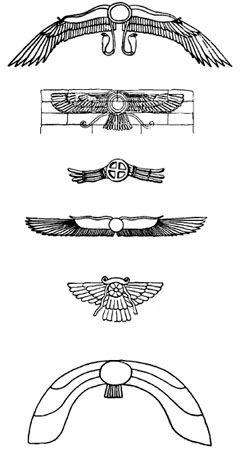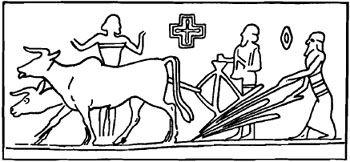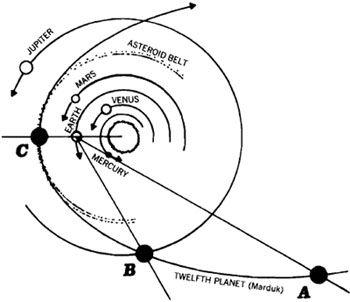The 12th Planet (39 page)
Authors: Zecharia Sitchin
Tags: #Non-Fiction, #Gnostic Dementia, #Fringe Science, #Retail, #Archaeology, #Ancient Aliens, #History

Indeed, all the peoples of the ancient world considered the periodic nearing of the Twelfth Planet as a sign of upheavals, great changes, and new eras. The Mesopotamian texts spoke of the planet's periodic appearance as an anticipated, predictable, and observable event:
The great planet:
At his appearance, dark red.
The Heaven he divides in half
and stands as Nibiru.
Many of the texts dealing with the planet's arrival were omen texts prophesying the effect the event would have upon Earth and Mankind. R. Campbell Thompson
(Reports of the Magicians and Astronomers of Nineveh and Babylon)
reproduced several such texts, which trace the progress of the planet as it "ringed the station of Jupiter" and arrived at the point of crossing, Nibiru:
When from the station of Jupiter
the Planet passes towards the west,
there will be a time of dwelling in security.
Kindly peace will descend on the land.
When from the station of Jupiter
the Planet increases in brilliance
and in the Zodiac of Cancer will become Nibiru,
Akkad will overflow with plenty,
the king of Akkad will grow powerful.
When Nibiru culminates....
The lands will dwell securely,
Hostile kings will be at peace,
The gods will receive prayers and hear supplications.

Fig. 112
The nearing planet, however, was expected to cause rains and flooding, as its strong gravitational effects have been known to do:
When the Planet of the Throne of Heaven
will grow brighter,
there will be floods and rains....
When Nibiru attains its perigee,
the gods will give peace;
troubles will be cleared up,
complications will be unravelled.
Rains and floods will come.
Like the Mesopotamian savants, the Hebrew prophets considered the time of the planet's approaching Earth and becoming visible to Mankind as ushering in a new era. The similarities between the Mesopotamian omens of peace and prosperity that would accompany the Planet of the Throne of Heaven, and the biblical prophesies of the peace and justice that would settle upon Earth after the Day of the Lord, can best be expressed in the words of Isaiah:
And it shall come to pass at the End of Days:
... the Lord shall judge among the nations
and shall rebuke many peoples.
They shall beat their swords into ploughshares
and their spears into pruning hooks;
nation shall not lift up sword against nation.
In contrast with the blessings of the new era following the Day of the Lord, the day itself was described by the Old Testament as a time of rains, inundations, and earthquakes. If we think of the biblical passages as referring, like their Mesopotamian counterparts, to the passage in Earth's vicinity of a large planet with a strong gravitational pull, the words of Isaiah can be plainly understood:
Like the noise of a multitude in the mountains,
a tumultous noise like of a great many people,
of kingdoms of nations gathered together;
it is the Lord of Hosts,
commanding a Host to battle.
From a far away land they come,
from the end-point of the Heaven
do the Lord and his Weapons of wrath
come to destroy the whole Earth....
Therefore will I agitate the Heaven
and Earth shall be shaken out of its place
when the Lord of Hosts shall be crossing,
the day of his burning wrath.
While on Earth "mountains shall melt ... valleys shall be cleft," Earth's axial spin would also be affected. The prophet Amos explicitly predicted:
It shall come to pass on that Day,
sayeth the Lord God,
that I will cause the Sun to go down at noon
and I will darken the Earth in the midst of daytime.
Announcing, "Behold, the Day of the Lord is come!" the prophet Zechariah informed the people that this phenomenon of an arrest in Earth's spin around its own axis would last only one day:
And it shall come to pass on that Day
there shall be no light—uncommonly shall it freeze.
And there shall be one day, known to the Lord,
which shall be neither day nor night,
when at eve-time there shall be light.
On the Day of the Lord, the prophet Joel said, "the Sun and Moon shall be darkened, the stars shall withdraw their radiance"; "the Sun shall be turned into darkness, and the Moon shall be as red blood."
Mesopotamian texts exalted the planet's radiance and suggested that it could be seen even at daytime: "visible at sunrise, disappearing from view at sunset." A cylinder seal, found at Nippur, depicts a group of plowmen looking up with awe as the Twelfth Planet (depicted with its cross symbol) is visible in the skies. (Fig. 113)
The ancient peoples not only expected the periodic arrival of the Twelfth Planet but also charted its advancing course.
Various biblical passages—especially in Isaiah, Amos, and Job—relate the movement of the celestial Lord to various constellations. "Alone he stretches out the heavens and treads upon the highest Deep; he arrives at the Great Bear, Orion and Sirius, and the constellations of the south." Or, "He smiles his face upon Taurus and Aries; from Taurus to Sagittarius he shall go." These verses describe a planet that not only spans the highest heavens but also comes in from the
south
and moves in a
clockwise
direction—just as we have deduced from the Mesopotamian data. Quite explicitly, the prophet Habakkuk stated: "The Lord from the south shall come ... his glory shall fill the Earth ... and Venus shall be as light, its rays of the Lord given."

Fig. 113
Among the many Mesopotamian texts that dealt with the subject, one is quite clear:
Planet of the god Marduk:
Upon its appearance: Mercury.
Rising thirty degrees of the celestial arc: Jupiter.
When standing in the place of the celestial battle:
Nibiru.
As the accompanying schematic chart illustrates, the above texts do not simply call the Twelfth Planet by different names (as scholars have assumed). They deal rather with the movements of the planet and the three crucial points at which its appearance can be observed and charted from Earth. (Fig. 114)
The first opportunity to observe the Twelfth Planet as its orbit brings it back to Earth's vicinity, then, was when it aligned with Mercury (point A)—by our calculations, at an angle of 30 degrees to the imaginary celestial axis of Sun–Earth–perigee. Coming closer to Earth and thus appearing to "rise" farther in Earth's skies (another 30 degrees, to be exact), the planet crossed the orbit of Jupiter at point B. Finally, arriving at the place where the celestial battle had taken place, the perigee, or the Place of the Crossing, the planet is Nibiru, point C. Drawing an imaginary axis between Sun, Earth and the perigee of Marduk's orbit, observers on Earth first saw Marduk aligned with Mercury, at a 30° angle (point A). Progressing another 30°, Marduk crossed the orbital path of Jupiter at point B.

Fig. 114.
THE RE-APPEARANCE OF THE TWELFTH PLANET
.
Then, at its apogee (point C) Marduk reached The Crossing: back at the site of the Celestial Battle, it was closest to Earth, and began its orbit back to distant space.
The anticipation of the Day of the Lord in the ancient Mesopotamian and Hebrew writings (which were echoed in the New Testament's expectations of the coming of the Kingship of Heaven) was thus based on the actual experiences of Earth's people: their witnessing the periodic return of the Planet of Kingship to Earth's vicinity.
